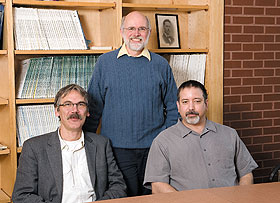  |
| HOME | THIS ISSUE | CALENDAR | GRANTS | BACK ISSUES | < BACK | NEXT > |
Cell biologists to study gene transfer and evolutionary descentby Cindy Weiss - December 8, 2008
| ||||
Johann Peter Gogarten, professor of molecular and cell biology in the College of Liberal Arts and Sciences, will begin work in January on a new five-year project to unearth the “roots” of the Darwin-inspired Tree of Life. The project is funded by a $2.5 million grant from the National Science Foundation. The research is the first in the select NSF “Assembling the Tree of Life” grant program to examine how microbes fit into the pattern of evolutionary descent. Gogarten, who has studied the early evolution of life for more than 20 years, says that most of the project will involve computational biology – his specialty. His research team will systematically search for clues, ancient and modern, of microbes transferring genes horizontally, events that complicate the picture of evolutionary heredity, which is usually depicted as the tree of life. He and his collaborators will build a databank of gene transfer events to reveal the impact of horizontal gene transfer on evolutionary descent. Challenging a concept In the “tree” metaphor, species branch off from a common trunk, limbs may reach dead ends, and new branches develop, giving rise to new lineages. In announcing the Tree of Life grant program in 2002, NSF referred to Charles Darwin’s concept that all life, from the smallest microbe to the largest vertebrate, is connected through genetic relatedness. “This ‘Tree of Life’ summarizes all we know about biological diversity and underpins much of modern biology, yet many of its branches remain poorly known and unresolved,” the agency pointed out. But evidence is mounting that microbes frequently transfer genes horizontally, causing much more rapid changes in genomes than the vertical, or familiar parent-to-offspring, transfer of genes would allow. This method of development challenges the concept of shared ancestry that the tree of life depicts. Horizontal Gene Transfer (HGT) presents a complicated picture, with microbes transferring genes among themselves, trading traits within a generation, across species, and even between domains of life. It may mean that the “tree” of life is more like a network or a web, as Gogarten describes it. Even Darwin wrote in his notes that the “tree” of life might not be the most descriptive metaphor, he points out. In the past 30 to 40 years, the implications of HGT have caused many biologists to take another look at the way evolution works. Gogarten became interested in the topic in the late 1980s when he was a postdoctoral fellow at the University of California at Santa Cruz. An unintended consequence of his research got him interested in looking at the early evolution of life.
He noticed in studying genetic sequences that types of microbes thought to be distinct appeared to have swapped genes with each other. “Genomes change much more rapidly than anyone assumed before,” says Gogarten. “The sheer amount of gene swapping that goes on in the microbial world caught us by surprise.” Building a database In building a database of HGT for the NSF project, Gogarten will use sophisticated analytical techniques and complex computational programs to analyze more factors and offer a more definitive clearinghouse of information that other scientists can build on. It will enable scientists to recognize patterns in horizontal gene transfer and expand the picture of how evolution occurs. The ultimate goal, Gogarten wrote in his NSF proposal, is to address the question, “Can the large-scale structure of the tree/web of life be discerned?” Eleven researchers will be involved in the work overall, including two other co-principal investigators at UConn and co-principal investigators and researchers at the University of Georgia and East Carolina University. Postdoctoral fellows, graduate students, and undergraduate students also will work on the project. Kenneth Noll, professor of molecular and cell biology in CLAS and a co-principal investigator, will study the Thermotogales, bacteria that thrive in extreme heat and are considered prime examples of horizontal gene transfer. As many as a quarter of their genes seem to have come from archaea, organisms that were first defined as a separate domain of life from bacteria in 1977. Noll will analyze data to see the impact of HGT on archaea and to find out how Thermotogales use archaeal genes. R. Thane Papke, assistant professor of molecular and cell biology, another co-PI, will study the Haloarchaea, a group of archaea that grow in high-salt environments. He is interested in rates of HGT, who the exchange partners are, and what role HGT plays in the generation and maintenance of prokaryotic diversity within and between closely related species and higher taxonomic ranks. |
| ADVANCE HOME UCONN HOME |

